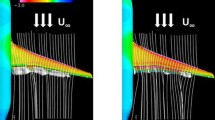Abstract
Aircraft flap mechanisms require high safety standards because they must withstand large, complex forms of aerodynamic loads during flight. This paper proposes a computational analysis methodology for verifying the design of the aircraft flap-driving mechanism through MBD (Multi-Body Dynamics) and investigates the operating environment of the flap for analysis. Specifically, the aerodynamic loads obtained from CFD (Computational Fluid Dynamics) were applied using One-way and two-way Co-Simulation methods to analyze the MBD. From the analysis, the required actuator capacity to drive the flap and mechanical jamming between the rolle and the rail were investigated using the proposed flap mechanism analysis methodology. The analysis results indicated that the flap model under this study experienced mechanical jamming during flap deployment.






























Similar content being viewed by others
Data availability
Opening the data in public is not available. Please contact author via email if required.
References
Kluga N (1991) A study of flap management, an analysis of the consequences of flap management, and a search for possible causes. J Aviat/Aerosp Educ Res 1(3):10–25. https://doi.org/10.15394/jaaer.1991.1026
Zaccai D (2014) Design framework for trailing edge high-lift systems: a knowledge based engineering application
**ang F, Cui W, Zhong Y (2011) The failure mode analysis of motion mechanism for airbus A320 flap. In: International Conference on quality, reliability, risk, maintenance, and safety engineering, pp 64–66. https://doi.org/10.1109/ICQR2MSE.2011.5976570
Zierath J, Woernle C, Heyden T (2009) Elastic multibody models of transport aircraft high-lift mechanisms. J Aircr 46(5):1513–1524. https://doi.org/10.2514/1.37583
Yoshida T, Mizusaki Y, Taki T (2004) Analysis and rig test in EMB170 flap mechanism development. In: 24th International Congress of the aeronautical sciences (ICAS), pp 1–4
Li Y, Han Y, Xuefeng Y, Jianguo L, Jie L (2020) Transmission efficiency of the motion mechanism in high-lift devices. J Aircr 57(4):761–772. https://doi.org/10.2514/1.C035927
Zhou XC, Xue P, Luo YB, Lu JG, Zhang C (2022) A recovery mechanism for flap system of large aircraft with actuator failure. Int J Prot Struct 13(3):539–554. https://doi.org/10.1177/20414196221087338
Korkmaz E (2023) FLAP mechanism design and analysis
MSC Software (2022) Adams Product Documentation
MSC Software (2022) MSC Nastran Documentation
MSC Software (2022) scFLOW User's Guide Operation
Gudmundsson S (2022) Chapter 10—the anatomy of lift enhancement. General aviation aircraft design (Second Edition). Butterworth-Heinemann, Boston, pp 415–479
Gudmundsson S (2014) Chapter 8—the anatomy of the airfoil. General aviation aircraft design. Butterworth-Heinemann, Boston, pp 235–297
ATR Aircraft (2018) Flight crew training manual 42/72-600 normal, abnormal & emergency procedures, pp 37–56
Office of Civil Aviation (2022) RKSI AD 2.24 Chart-12 (2–51) INSTR APCH CHART(7)
Office of Civil Aviation (2022) RKSS AD 2.24 Chart-11 (2–29) INSTR APCH CHART(10)
Office of Civil Aviation (2022) RKPC AD 2.24 Chart-11 (2–21) INSTR APCH CHART(43)
Office of Civil Aviation (2022) RKPK AD 2.24 Chart-11 (2–26) INSTR APCH CHART(15)
Guzhva VS, Curtis T, Borodulin V (2013) Market analysis for small and mid-size commercial turboprop aircraft. Scholarly commons
ATR Aircraft (2023) ATR 72-600 The most fuel efficient regional aircraft
BAE SYSTEMS (2023) De Havilland Canada DHC-8 Dash 8
MAJESTIC Software (2023) Landing the Q400 Update Version 7
ATR Aircraft (2009) ATR training & flight operations services—performance. 103
MAJESTIC Software (2023) Speed Cards
Pendergraft O Jr, Ingraldi A, Re R, Kariya T (1989) Nacelle/pylon interference study on a 1/17th-scale, twin-engine, low-wing transport model. In: 25th Joint Propulsion Conference. https://doi.org/10.2514/6.1989-2480
Qiu Y, Bai J, Qiao L (2018) Aerodynamic effects of wing-mounted engine nacelle on high-lift configuration of turboprop airliner. J Aircr 55(3):1082–1089. https://doi.org/10.2514/1.C034529
Bombardier (2016) AEROPLANE OPERATING MANUL DHC-8-Q400. Bombardier
Johnson KL (1987) Contact mechanics. Cambridge University Press
Tech Steel & Materials (n.d.) Stainless Steel 17–4PH
Giesbers J (2012) Contact mechanics in MSC ADAMS
Artero-Guerrero JA, Pernas-Sánchez J, López-Puente J, Varas D (2014) On the influence of filling level in CFRP aircraft fuel tank subjected to high velocity impacts. Compos Struct 107:570–577. https://doi.org/10.1016/j.compstruct.2013.08.036
Diaz-Alvarez J, Olmedo A, Santiuste C, Miguelez MH (2014) Theoretical estimation of thermal effects in drilling of woven carbon fiber composite. Materials (Basel) 7(6):4442–4454. https://doi.org/10.3390/ma7064442
Calik E, Ersoy N, Oz FE (2018) Experimental and numerical progressive failure analysis of corrugated core type composite sandwich structure. In: 18th European Conference on composite materials, pp 1–8
Kumbhare N, Moheimani R, Dalir H (2021) Analysis of composite structures in curing process for shape deformations and shear stress: basis for advanced optimization. J Compos Sci 5(2):63. https://doi.org/10.3390/jcs5020063
Dababneh O, Kipouros T, Whidborne J (2018) Application of an efficient gradient-based optimization strategy for aircraft wing structures. Aerospace 5(1):3. https://doi.org/10.3390/aerospace5010003
Steger JL, Dougherty FC, Benek JA (1983) A Chimera grid scheme. Adv Grid Gener 5:59–69
ANSYS (2020) ANSYS Fluent Theory Guide, pp 44–49
Lissaman PBS (1983) Low-Reynolds-Number Airfoils. Annu Rev Fluid Mech 15(1):223–239. https://doi.org/10.1146/annurev.fl.15.010183.001255
Acknowledgements
This work was supported by the Technology Innovation Program (RS-2023-00257080, Development for Integrated Composite Control Surface and Mechanism) funded by the Ministry of Trade, Industry & Energy(MOTIE, Korea) and the Institute of Engineering Research at Seoul National University.
Author information
Authors and Affiliations
Corresponding author
Ethics declarations
Conflict of Interest
The authors confirm that there is no financial or personal conflict of interest with any third party regarding this article’s contents. On behalf of all authors, the corresponding author states that there is no conflict of interest.
Additional information
Communicated by Jae Hyuk lim.
Publisher's Note
Springer Nature remains neutral with regard to jurisdictional claims in published maps and institutional affiliations.
Rights and permissions
Springer Nature or its licensor (e.g. a society or other partner) holds exclusive rights to this article under a publishing agreement with the author(s) or other rightsholder(s); author self-archiving of the accepted manuscript version of this article is solely governed by the terms of such publishing agreement and applicable law.
About this article
Cite this article
Chung, M.G., Han, J.Y., Kim, K.B. et al. MBD-CFD Coupled Analysis for Design Verification of Aircraft Flap Mechanism. Int. J. Aeronaut. Space Sci. (2024). https://doi.org/10.1007/s42405-024-00755-z
Received:
Revised:
Accepted:
Published:
DOI: https://doi.org/10.1007/s42405-024-00755-z




